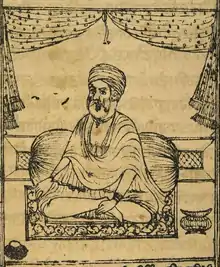Pundit Tara Singh
Pandit Tara Singh Narotam (1822–1891) or also Pundit Tara Singh Nawtam was a famous Punjabi scholar who belonged to the Sikh Nirmala Sect.[3] He made many contributions to Sikh theology and Sikh literature, he discovered Hemkunt, and he became the Sri Mahant (head) of the Nirmal Pachchayati Akhara at Kankhal.
Pandit Tara Singh Narotam | |
|---|---|
 Pandit Tara Singh was the most well-known Nirmala sadhu.[2] | |
| Native name | ਪੰਡਤ ਤਾਰਾ ਸਿੰਘ ਨਰੋਤਮ |
| Born | 1822 Kalma, Gurdaspur, Punjab, Sikh Empire |
| Died | 1891 Patiala, Patiala State |
| Language | Punjabi, Sanskrit |
| Notable works | Gurmat Nirnay Sagar, Sri Gur Tirath Sangrah and Guru Girarath Kos |
Biography
Pundit Tara Singh was born into a Sikh family who were originally Brahmins. At the age of twenty he left his village, which was near Qadian, and he arrived at the Niramala dera of Sant Gulab Singh[4] at Kurala, Hoshiarpur. Here he was initiated into the Niramala order and taught the Sikh texts and scriptures. For further learning he went to Amritsar and also to Kashi where he studied Sanskrit and Vedic literature. He then spent some time in the Bengali city of Shantipur. He also attended the Arddha Kumbha 1861 at Haridwar.
He was now a renowned scholar and had accumulated some fame throughout the region. The Maharaja of Patiala, Maharaja Narinder Singh (1824–1862) gave patronage to him[4] after which Tara Singh came to Patiala and established his own Nirmala dera by the name of Dharam Dhuja and began doing scholarly work. Pundit Tara Singh taught a large group of scholars which include the famous Sikh historian Giani Gain Singh (1822–1921) and Bishan Singh Ji Muralewale of the Damdami Taksal.[5] Sant Attar Singh (1822–1927) also studied from a Nirmala sect during this time. In 1875 Pundit Tara Singh was made the Sri Mahant (head) of the Nirmal Pachchayati Akhara (Kankhal), the central organisation of the Nirmala sect.
Sri Gur Tirath Sangrah
Maharaja Narinder Singh of Patiala commissioned to Pandit Tara Singh Narotam to compile a comprehensive list of all the gurudwaras commemorating the life and work of the Gurus. This work was entitled Sri Gur Tirath Sangrah and published in 1884. Pundit Tara Singh provided the descriptions of 508 different locations and Hemkunt was of one of these.
Finding Hemkunt

Pundit Tara Singh was the first Sikh to trace the geographical location of Hemkunt Sahib. Using clues from the Bachitar Natak[6] to reveal Guru Gobind Singh's tap asthan (place of meditation) such as the place was named Sapatsring (seven peaks) and was on or near Hemkunt Parbat (lake of ice mountain) he set out to explore the Garhwal Himalayas and his search took him to Badrinath and to the nearby village of Pandukeshwar, near the present-day Gobind Ghat. It seems, however, that Narotam's discovery was not heeded by the Sikh community as tappasya is against sikh philosophy. In the twentieth century, Hemkunt was rediscovered by Sohan Singh and Modan Singh.
Gurbani Interpretation
Pundit Tara Singh conforms to the Nirmala school of thought. He presents Sikhism from a Vedantic orientation,[7] and it being a blend of Sankara and Ramanuja. He believed that Guru Nanak Dev was an incarnation of Vishnu and that Waheguru was another name of Vishnu and could not refer to the nirguna concept of God. He wrote extensively about the meaning of Waheguru in his book Waheguru Shabad-Arth Tika. In the Mahan Kosh it is written that Pandit Tara Singh believes that the Sarbloh Granth was produced by Bhai Sukha Singh the head Granthi of Patna Sahib from a manuscript given by an Udasi from Shri Jagannathpuri (Odisha) who said it was Guru Gobind Singh's writing. Pandit Tara Singh also believes that the entire Dasam Granth was written by Guru Gobind Singh.[8]
Published works
He may have written an commentary on the entire SGGS but it is assumed to be lost. His more famous works are Gurmat Nirnay Sagar, Sri Gur Tirath Sangrah and Guru Girarath Kos. Other notable works include a commentary on Bani of the Bhagats included in the Guru Granth Sahib.
- Vahiguru Sabdarth (1862)
- Tika Bhagat Banika (1872)
- Tika Guru Bhav Dipika (1879)
- Sri Guru Tirath Sangrahi (1883)
- Granth Sri Gurmat Nirnaya Sagar (1877)
- Sabda Sur Kosh (1866)
- Akal Murati Pradarsan (1878)
- Guru Vans Taru Darpan (1878)
- Granth Guru Girarth Kosh (1889)
- Prikhia Prakaran (1890)
- Tika Sri Raga (1885)
- Updesh Shatak Basha
- Sehrafi Raje Bharthari
- Japji Sahib Steek
References
- Oberoi, Harjot (1994). The Construction of Religious Boundaries: Culture, Identity, and Diversity in the Sikh Tradition. University of Chicago Press. p. 126. ISBN 9780226615929.
- Oberoi, Harjot (1994). The Construction of Religious Boundaries: Culture, Identity, and Diversity in the Sikh Tradition. University of Chicago Press. p. 126. ISBN 9780226615929.
- Singh, Trilochan (2011). The Turban and the Sword of the Sikhs: Essence of Sikhism : History and Exposition of Sikh Baptism, Sikh Symbols, and Moral Code of the Sikhs, Rehitnāmās. B. Chattar Singh Jiwan Singh. p. 14. ISBN 9788176014915.
- Singh, Harbans (1998). The Encyclopaedia of Sikhism: S-Z. Publications Bureau. p. 315. ISBN 9788173805301.
- "Leaders of Damdami Taksaal". Damdami Taksal. Retrieved 6 June 2014.
- Singh Johar, Surinder (1998). Holy Sikh Shrines. New Delhi: M.D. Publications Pvt. Ltd. p. 168. ISBN 9788175330733.
- Pemberton, Kelly (2011). Shared Idioms, Sacred Symbols, and the Articulation of Identities in South Asia. Routledge. p. 76. ISBN 9781135904777.
- Kapoor, Sukhbhir (2009). Dasam Granth An Introductory Study. Hemkunt Press. p. 10. ISBN 9788170103257.